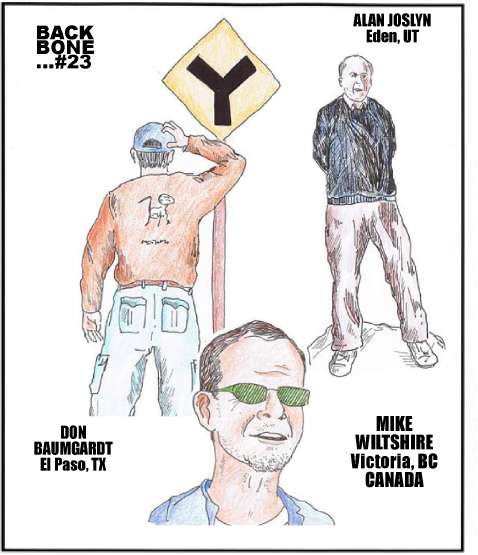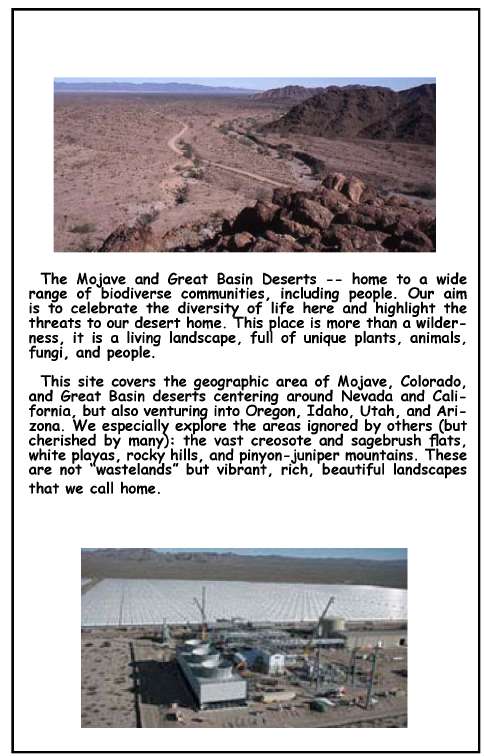
the societal mass. That is what we will leave for our children and grandchildren the way
things are going.
things are going.
And
Nimkin's words are at loggerheads with one of Edward Abbey's keenest
intuitions,
written in 1967: "There may be some...who virtually identify quantity with quality and
therefore assume that the greater the quantity of traffic, the higher the value received...
There will be other[s]...who share my basic assumption that wilderness is a necessary
part of civilization and that it is the primary responsibility of the national park system to
preserve intact and undiminished what little still remains." (Desert Solitaire, P. 47).
written in 1967: "There may be some...who virtually identify quantity with quality and
therefore assume that the greater the quantity of traffic, the higher the value received...
There will be other[s]...who share my basic assumption that wilderness is a necessary
part of civilization and that it is the primary responsibility of the national park system to
preserve intact and undiminished what little still remains." (Desert Solitaire, P. 47).
On
a late September weekend many years ago Gail and I lay in the early
afternoon sun
on a long gray and white boulder protruding from a meadow along the Blackbird Knob
Trail, a quarter mile north of the tiny Dolly Sods Wilderness in northeastern West Vir
ginia. We gazed at a delicate stream of high, white cirrus clouds; cumulus clouds floated
here and there like balls of cotton.
on a long gray and white boulder protruding from a meadow along the Blackbird Knob
Trail, a quarter mile north of the tiny Dolly Sods Wilderness in northeastern West Vir
ginia. We gazed at a delicate stream of high, white cirrus clouds; cumulus clouds floated
here and there like balls of cotton.
The
meadow was a tweedy carpet of grass, bushes and tiny trees extending a
quarter
of a mile to a tapestry of balsam fir, spruce and maple. Eight miles to the west a slender,
blue-green mountain was visible just above a broad, sloping knob matted with evergreens.
of a mile to a tapestry of balsam fir, spruce and maple. Eight miles to the west a slender,
blue-green mountain was visible just above a broad, sloping knob matted with evergreens.

But does a linear pattern of escalating growth,
even on a gross economic level, benefit such communities
over the long run?
That so many otherwise insightful and compassionate people
believe that it does is evidence of an ideological coup
of the first order by the right wing.
To
their right were three rounded hills atop Cabin Mountain, a sweet green
ridge rising
out of the western rim of the Dolly Sods plateau.
out of the western rim of the Dolly Sods plateau.
We had found solitude. I shut my eyes and let my mind wander in the white radiance
of the sun.
of the sun.
Farther
down the trail we camped beneath giant hemlocks alongside Red Creek,
across
from stands of fluttering aspens and red-turning maples.
from stands of fluttering aspens and red-turning maples.
After
discovering Dolly Sods we often spent afternoons on the overlooks, and
I ven
tured forth on backpacking trips in the area. One Friday afternoon in July several years
later we drove up to Dolly Sods, planning an extended day hike on the Blackbird Knob
Trail the next morning. But when we got to the national forest campground the thin pla
teau was crawling with people; there were license plates from Maryland, Pennsylvania,
and Ohio, as well as West Virginia.
tured forth on backpacking trips in the area. One Friday afternoon in July several years
later we drove up to Dolly Sods, planning an extended day hike on the Blackbird Knob
Trail the next morning. But when we got to the national forest campground the thin pla
teau was crawling with people; there were license plates from Maryland, Pennsylvania,
and Ohio, as well as West Virginia.
The solitude was gone.
Many of these people had probably been seeking it, too.
We
retreated to a nearby state park in Canaan Valley, pitched our tent
before sunset,
and walked through the amiable woods the next day.
and walked through the amiable woods the next day.
And
that's the tragedy of the East. All the rain and trees and wide rivers
support mil
lions of people, but with rare exceptions there are too damn many of us for the public
lands to offer more than glimmers of wildness and solitude. That's why the impact of the
amenities economy on national parks and monuments in the West, as well as the impact
of land development near wilderness areas there, is crucial for everyone.
lions of people, but with rare exceptions there are too damn many of us for the public
lands to offer more than glimmers of wildness and solitude. That's why the impact of the
amenities economy on national parks and monuments in the West, as well as the impact
of land development near wilderness areas there, is crucial for everyone.
When
people live anywhere near such sacred lands the way they each live -
their "ho-
gan," in other words - needs to reflect the wildness of the land. More plainly, key Western
parks and monuments need buffer zones: areas of transition and cleansing. Quiet places
with small homes, modest lifestyles, low density housing, and a conspicuous absence of
private businesses operating inside the Park Service land. I would forbid luxury resorts or
oversized homes within thirty miles of any park or monument.
gan," in other words - needs to reflect the wildness of the land. More plainly, key Western
parks and monuments need buffer zones: areas of transition and cleansing. Quiet places
with small homes, modest lifestyles, low density housing, and a conspicuous absence of
private businesses operating inside the Park Service land. I would forbid luxury resorts or
oversized homes within thirty miles of any park or monument.
In other words, communities that are carefully zoned down.
This
also means eradicating privatization within all levels of the National
Park Service.
And closing some roads within the parks and monuments and restricting traffic on others,
and fostering hiking and backpacking, limited to solo ventures or small groups. Mountain
bikers (sigh): I would require them to ride bikes and wear clothing with coloration that
blends into the landscape, and to travel solo or in widely separated groups of no more
than three or four. In the immense Denali National Park, for example, there is one fifteen
mile paved road. To go on the 75 miles of rough dirt road beyond you have to walk, bike,
or go by shuttle bus.
And closing some roads within the parks and monuments and restricting traffic on others,
and fostering hiking and backpacking, limited to solo ventures or small groups. Mountain
bikers (sigh): I would require them to ride bikes and wear clothing with coloration that
blends into the landscape, and to travel solo or in widely separated groups of no more
than three or four. In the immense Denali National Park, for example, there is one fifteen
mile paved road. To go on the 75 miles of rough dirt road beyond you have to walk, bike,
or go by shuttle bus.
And I would forbid land development within five miles of any large wilderness area.
Buffer
zones can be pieced together over a generation or two so that people
aren't de
prived of the use of their land during their lifetimes. Buy-out packages should be not only
fair, but generous; we can insist on that.
prived of the use of their land during their lifetimes. Buy-out packages should be not only
fair, but generous; we can insist on that.
Expect
a hue and cry from local community boosters and from people in the
ameni
ties economy and to be shrugged off by mainstream environmental groups. Expect expla
nations like these: buffer zones would limit public access, would disregard key stakehold
ers, are Utopian, un-American, un-pragmatic, divisive, socialist, et cetera. But I think the
sticking point for many of these people is that however much they may appreciate the
national parks and monuments, they are not sacred places to them. Nor are wilderness
areas.
ties economy and to be shrugged off by mainstream environmental groups. Expect expla
nations like these: buffer zones would limit public access, would disregard key stakehold
ers, are Utopian, un-American, un-pragmatic, divisive, socialist, et cetera. But I think the
sticking point for many of these people is that however much they may appreciate the
national parks and monuments, they are not sacred places to them. Nor are wilderness
areas.
Otherwise they would fight to protect the solitude there.
Scott Thompson lives in Beckley, WVand is a regular contributor to The Zephyr
17
